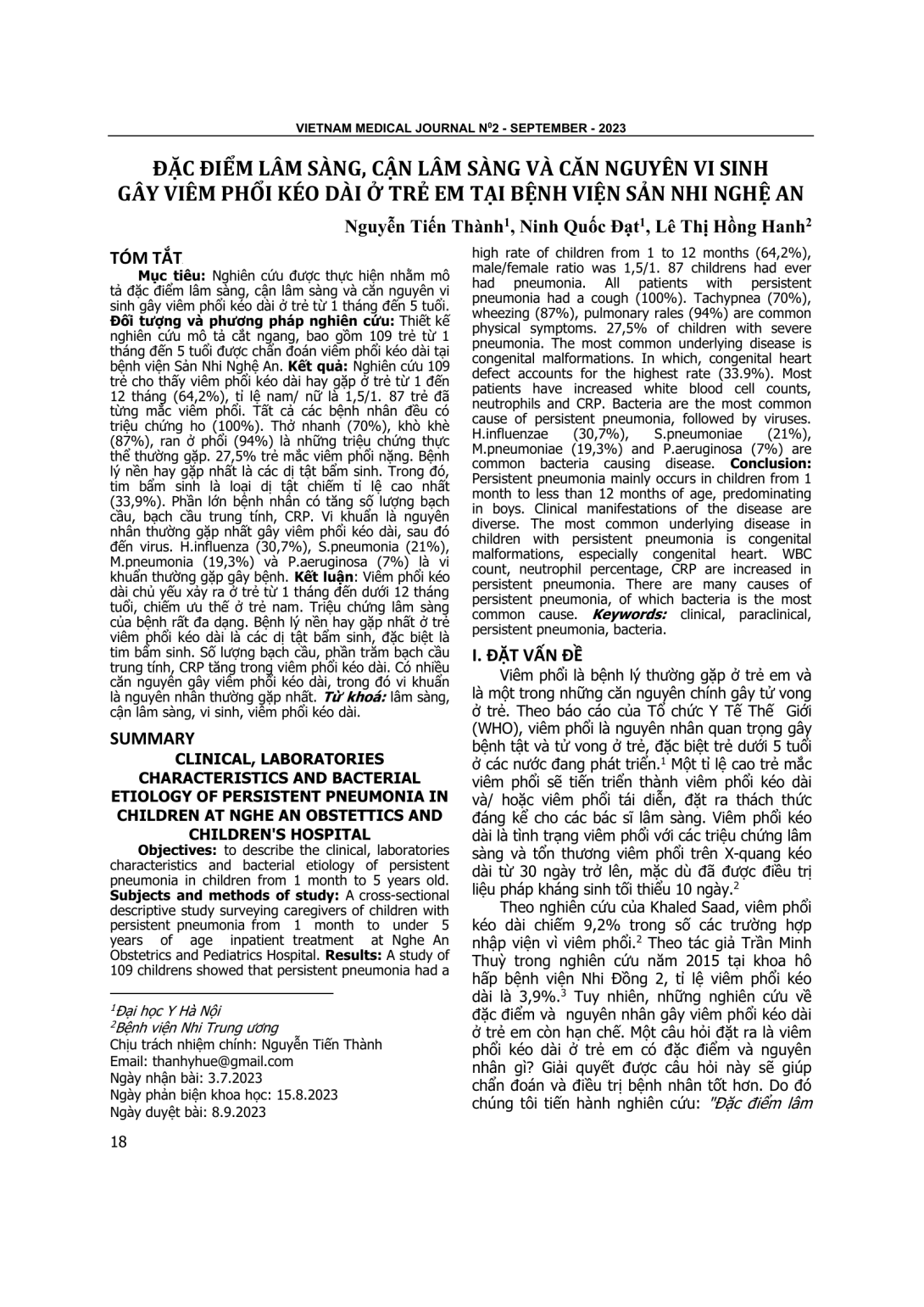
Nghiên cứu được thực hiện nhằm mô tả đặc điểm lâm sàng, cận lâm sàng và căn nguyên vi sinh gây viêm phổi kéo dài ở trẻ từ 1 tháng đến 5 tuổi. Đối tượng và phương pháp nghiên cứu: Thiết kế nghiên cứu mô tả cắt ngang, bao gồm 109 trẻ từ 1 tháng đến 5 tuổi được chẩn đoán viêm phổi kéo dài tại bệnh viện Sản Nhi Nghệ An. Kết quả: Nghiên cứu 109 trẻ cho thấy viêm phổi kéo dài hay gặp ở trẻ từ 1 đến 12 tháng (64,2%), tỉ lệ nam/ nữ là 1,5/1. 87 trẻ đã từng mắc viêm phổi. Tất cả các bệnh nhân đều có triệu chứng ho (100%). Thở nhanh (70%), khò khè (87%), ran ở phổi (94%) là những triệu chứng thực thể thường gặp. 27,5% trẻ mắc viêm phổi nặng. Bệnh lý nền hay gặp nhất là các dị tật bẩm sinh. Trong đó, tim bẩm sinh là loại dị tật chiếm tỉ lệ cao nhất (33,9%). Phần lớn bệnh nhân có tăng số lượng bạch cầu, bạch cầu trung tính, CRP. Vi khuẩn là nguyên nhân thường gặp nhất gây viêm phổi kéo dài, sau đó đến virus. H.influenza (30,7%), S.pneumonia (21%), M.pneumonia (19,3%) và P.aeruginosa (7%) là vi khuẩn thường gặp gây bệnh. Kết luận: Viêm phổi kéo dài chủ yếu xảy ra ở trẻ từ 1 tháng đến dưới 12 tháng tuổi, chiếm ưu thế ở trẻ nam. Triệu chứng lâm sàng của bệnh rất đa dạng. Bệnh lý nền hay gặp nhất ở trẻ viêm phổi kéo dài là các dị tật bẩm sinh, đặc biệt là tim bẩm sinh. Số lượng bạch cầu, phần trăm bạch cầu trung tính, CRP tăng trong viêm phổi kéo dài. Có nhiều căn nguyên gây viêm phổi kéo dài, trong đó vi khuẩn là nguyên nhân thường gặp nhất.
To describe the clinical, laboratories characteristics and bacterial etiology of persistent pneumonia in children from 1 month to 5 years old. Subjects and methods of study: A cross-sectional descriptive study surveying caregivers of children with persistent pneumonia from 1 month to under 5 years of age inpatient treatment at Nghe An Obstetrics and Pediatrics Hospital. Results: A study of 109 childrens showed that persistent pneumonia had a high rate of children from 1 to 12 months (64,2%), male/female ratio was 1,5/1. 87 childrens had ever had pneumonia. All patients with persistent pneumonia had a cough (100%). Tachypnea (70%), wheezing (87%), pulmonary rales (94%) are common physical symptoms. 27,5% of children with severe pneumonia. The most common underlying disease is congenital malformations. In which, congenital heart defect accounts for the highest rate (33.9%). Most patients have increased white blood cell counts, neutrophils and CRP. Bacteria are the most common cause of persistent pneumonia, followed by viruses. H.influenzae (30,7%), S.pneumoniae (21%), M.pneumoniae (19,3%) and P.aeruginosa (7%) are common bacteria causing disease. Conclusion: Persistent pneumonia mainly occurs in children from 1 month to less than 12 months of age, predominating in boys. Clinical manifestations of the disease are diverse. The most common underlying disease in children with persistent pneumonia is congenital malformations, especially congenital heart. WBC count, neutrophil percentage, CRP are increased in persistent pneumonia. There are many causes of persistent pneumonia, of which bacteria is the most common cause.
- Đăng nhập để gửi ý kiến
